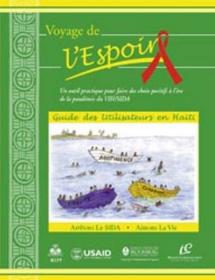Journey of Hope: A Practical Guide for Making Positive Life Choices – Haiti User’s Guide
This user’s guide is part of the Haiti Journey of Hope Kit – a set of practical experiential learning activities designed to address a range of HIV and AIDS related issues, in particular HIV prevention.
It guides participants to develop life skills that can help them deal with different situations, linked to staying healthy and achieving their goals and dreams in life. The Journey is represented by: a mass of water, where there are crocodiles, hippos, and snakes, representing dangers in life including the HIV virus and other STIs; narrow bridges and three boats, representing prevention methods of abstinence, faithfulness, and condom use; and future islands, representing what participants most want and value in life– their future goals and dreams.
The overall aims of Journey of Hope are to:
- Help people in Haiti stop the spread of HIV and have a healthy life
- Enable people to be in relationships they want, in a way that keeps them safe from HIV infection
- Give hope to people for a future that helps them choose to abstain, be faithful, or use condoms to prevent HIV infection.
To achieve the overall aims, Journey of Hope:
- Promotes open discussions about sexual behavior and issues related to HIV and AIDS
- Involves people in fun and interesting ways using participatory story telling with interactive visual aids and symbols
- Provides the choice and helps participants to develop skills that empower them to protect themselves from HIV protection (abstinence, faithfulness, and condom use)
- Encourages people to plot their own ways to a safer lifestyle to enable them to achieve outcomes they really want and value in life;
- Applies a range of powerful and practical communication tools for behavior change
- Enables people to develop skills in negotiating sexual matters in a relationship
- Clarifies issues around Voluntary Counseling and Testing
- Promotes support, compassion and positive living for those living with HIV and AIDS
Source: Johns Hopkins University Center for Communicaiton Programs
Date of Publication: March 25, 2019
SIMILIAR RESOURCES
Tools
Examples
- Adolescents Living with HIV (ALHIV) Toolkit
- Engaging Men in HIV and AIDS at the Service Delivery Level
- Toolkit for Transition of Care and Other Services for Adolescents Living with HIV
- Positive Connections: Leading Information and Support Groups for Adolescents Living with HIV
- Optimizing Entry Into and Retention in HIV Care and ART Adherence for PLWHA
- Consolidated Guideline on Sexual and Reproductive Health and Rights of Women Living with HIV
- Guidance for Providing Informed-Choice Counseling on Sexual Health for Women Interested in PrEP: Kenya and South Africa
- PrEP Communications Accelerator
- Ending the AIDS Epidemic for Adolescents, with Adolescents: A Practical Guide to Meaningfully Engage Adolescents in the AIDS Response
- Participation Guide: Involving Those Directly Affected in Health and Development Communication Programs

